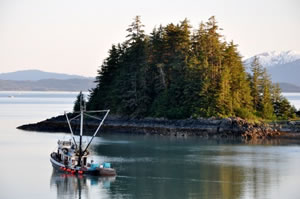SALMON TROLLING BOATS
Work on a trolling boat within the salmon fishery can be demanding. While work might not be incredibly physically strenuous, it isn’t uncommon for workers to be busy for 17 hours in a single workday and to work for a month straight without any days off. Remember, these long work hours translate into lots of paid overtime and highly enjoyable paychecks at the end of the week. Trolling is a specific boat, which drags lures, bait and flashers slowly behind the boat to catch salmon. Leaders are pulled in and checked for fish where they are then gutted, cleaned, iced and stored until the boat can unload. Unloading trips depend usually on weather and the amount of space and fish onboard.
The salmon caught on a trolling boat are usually unscarred and very well preserved because of the method of catching. Troll caught salmon almost always fetch an excellent price by retailers. Fishermen have come to consider trolling an art of fishery because the types of bait, lures and depths of the drag must all be considered. It is highly suggested to look for work with a captain or skipper who has experience and success in the industry.
DID YOU KNOW…?
Trolling boats are small and often times it is only a skipper and another deckhand onboard. The deckhands responsibilities vary between cleaning and icing fish, cooking, running gear, making repairs and being on lookout.
Trolling boats are only allowed in Southeast Alaska. (Area 1 – Petersburg, Ketchikan, Wrangell, Sitka, Juneau).
Pay is based on the total amount of salmon caught in a season, which is usually between 12-15%. Deckhands can make anywhere from $4,000 – $8,000+ in a two-month season.
Jobs on a troller might mean that you are stuck in small living quarters and working long days. However, it is exciting and potentially high paying work that is considered far more fun than onshore seafood processing.


